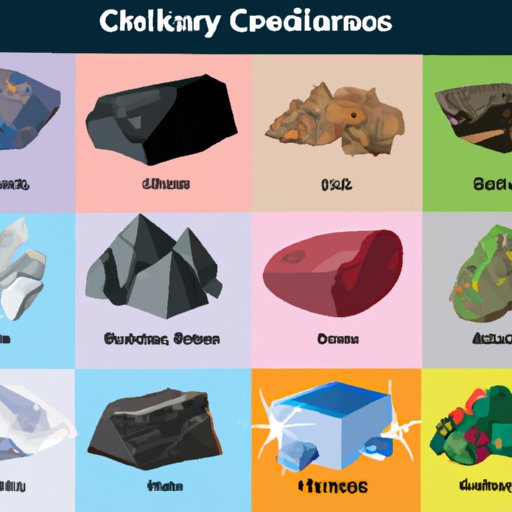Introduction
Rocks and minerals are both naturally occurring substances found in the Earth’s crust. They are both solid materials that have unique physical and chemical properties. While they may seem similar on the surface, there are some important differences between the two. It is essential to understand the distinction between rocks and minerals in order to identify them accurately. In this article, we will explore the fundamental differences between rocks and minerals, their varied characteristics, and a beginner’s guide for distinguishing them.

Exploring the Fundamental Differences Between Rocks and Minerals
Rocks are composed of multiple minerals, or mineral grains, which form together to create a larger material. According to the University of Arizona, “A rock is an aggregate of one or more minerals, or a body of undifferentiated mineral matter.” It is common for rocks to contain organic material, such as shells or fossilized remains, along with the mineral grains. Rocks can range greatly in size from microscopic particles to large boulders.
Minerals, on the other hand, are composed of only one element. They are made up of pure substances that have been formed by geological processes. Unlike rocks, minerals do not contain any organic material. Minerals typically form crystals and have a much smaller size than rocks. According to the United States Geological Survey, “A mineral is a naturally occurring inorganic element or compound having an orderly internal structure and characteristic chemical composition, crystal form, and physical properties.”
The Varied Characteristics of Rocks and Minerals
Rocks have a variety of characteristics, such as color, hardness, texture, and structure. These characteristics can vary greatly depending on the type of rock and the minerals it contains. For example, granite is a type of rock that is usually gray or pink in color and has a coarse texture. Sandstone, on the other hand, is a type of rock that is usually tan or yellow in color and has a fine-grained texture.
Minerals also have their own unique characteristics, including luster, cleavage, and chemical composition. Luster refers to the way light reflects off of the surface of the mineral. Cleavage is the tendency of some minerals to break along certain planes. Chemical composition is the combination of elements that make up the mineral. Some common examples of minerals include quartz, mica, and calcite.
A Comparison of Rocks and Minerals: The Key Contrasts
There are several key contrasts between rocks and minerals. The most obvious difference is that rocks are composed of multiple minerals, while minerals are made up of only one element. Rocks are generally larger in size than minerals. Additionally, rocks have different physical properties than minerals. For example, rocks are usually harder and more resistant to weathering and erosion than minerals.

Comparing Physical Properties of Rocks and Minerals
Rocks typically have a harder outer layer that makes them more resistant to weathering and erosion than minerals. This hard outer layer is often referred to as a “rind.” Minerals usually have a softer inner core, which makes them easier to break down. Additionally, rocks often have more varied colors and textures than minerals. For example, granite is a type of rock that has a wide range of colors, including gray, pink, and white.

Differentiating Rocks and Minerals: A Guide for Beginners
Identifying rocks and minerals can be a challenging task for beginners. However, there are some simple steps that can be taken to help differentiate between the two. First, observe the color and texture of the specimen. Second, identify the luster, cleavage, and hardness of the specimen. Finally, analyze the chemical composition of the specimen. By following these steps, it is possible to accurately distinguish between rocks and minerals.
Conclusion
In conclusion, understanding the differences between rocks and minerals is essential for identifying them accurately. Rocks are composed of multiple minerals, while minerals are made up of only one element. Rocks are generally larger in size than minerals and have different physical properties. These properties include a harder outer layer that makes them more resistant to weathering and erosion. Additionally, rocks often have more varied colors and textures than minerals. By observing the color and texture of the specimen, identifying the luster, cleavage, and hardness of the specimen, and analyzing the chemical composition of the specimen, it is possible to accurately distinguish between rocks and minerals.
For further information about the differences between rocks and minerals, check out the United States Geological Survey website at https://www.usgs.gov/.
(Note: Is this article not meeting your expectations? Do you have knowledge or insights to share? Unlock new opportunities and expand your reach by joining our authors team. Click Registration to join us and share your expertise with our readers.)
